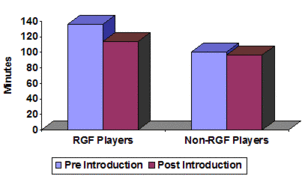Last week’s WAGER summarized a study by Ladouceur and Sévigny (2002) that examined the effects of video lottery terminal (VLT) symbol sequencing on players’ gambling behavior. This week, The WAGER expands on the effect of VLT features on gambling behavior by reviewing a research initiative aimed at reducing poor VLT playing strategies by incorporating responsible gaming features into VLT design.
The Nova Scotia Gaming Corporation (NSGC)1 integrated four responsible gaming features into 3,200 new VLTs introduced at various locations in the province between May 2001 and January 2002 (Schellinck & Schrans, 2002). These features include: (1) a permanent on-screen clock (2) a display of betting activity in cash amounts rather than credits (3) pop-up reminders of time spent playing at 60, 90 and 120 minutes (see Figure 1) and (4) a mandatory cash-out at 150 minutes.
Figure 1. On-Screen Displays of Responsible Gaming Features (Schellinck & Schrans, 2002)
To evaluate the impact of the responsible gaming features (RGF) on player behavior, the NSGC recruited 493 VLT players from 81 VLT locations in Nova Scotia and another 103 from a pre-existing database of gamblers. A total of 440 players met the inclusion criteria (i.e., resident of Nova Scotia, 19 years of age or older and played VLT games at least once a month). The NSGC collected baseline data in May 2001 (prior to the introduction of the new VLTs) and follow-up data in September, 2001, November, 2001 and February, 2002. Only 321 players remained eligible throughout the course of the study; of these, 222 completed all phases of the study, yielding an overall response rate of 69.2%. By the last follow-up, 58 players had stopped using VLTs and were excluded from analysis. The authors compared the gambling behaviors of players who voluntarily choose to switch to the new VLTs to players who continued to use the older models.
Players who switched to VLTs with responsible gaming features reduced their session length significantly (Figure 2) while those who continued to use the older VLTs evidenced no significant change in length of play. However, shorter sessions did not translate into lower levels of expenditure; there was no significant change in expenditure for either group. Switching to the RGF machines had the effect of increasing the rate of expenditure by 16.4%, suggesting that the new features somehow encouraged players to spend at an increased rate.
Figure 2. Session length among players using VLTs with and without responsible gaming features.
These results might be due in part to a novelty effect; the study took place during the first year the new machines were in operation. Longer term studies are needed to determine whether the influence of the responsible gaming features will wane as players become accustomed to them. Another very important limitation is that the comparison groups were self-selected instead of randomized. Players voluntarily switched to the new terminals. Perhaps those who switched to the new machines were concerned with their gambling behavior and looking for ways to reduce amount of time they spent gambling. Finally, it is worth noting that a reduction in session length was offset by an increase in the rate of expenditure; this is similar to the findings that people smoking “low tar” cigarettes smoked more to keep their nicotine blood levels constant. This raises important questions about whether these new features might be inadvertently creating new gambling risks.
Nova Scotia is the first area in North America to systematically introduce responsible gaming features on VLTs. Evaluating the effectiveness of responsible gaming features on excessive gambling is a necessary and important step towards creating safer gambling environments. The results from this study were mixed and suggest a need for continued study and design modification.
Comments on this article can be addressed to Rachel Kidman.
Notes
1. Gaming entertainment in Canada is solely a government enterprise; the NSGC manages the gaming business on behalf of the government of Nova Scotia.
References
Ladouceur, R., & Sevigny, S. (2002). Symbols presentation modality as a determinant of gambling behavior. Journal of Psychology, 136(4), 443-448.
Schellinck, T., & Schrans, T. (2002). Atlantic Lottery Corporation Video Lottery Responible Gaming Feature Research – Final Report. Focal Research Consultants Ltd. Retrieved November 8, 2002, from the World Wide Web:
http://www.gamingcorp.ns.ca/products/products.htm






